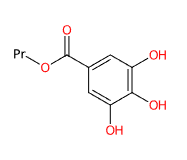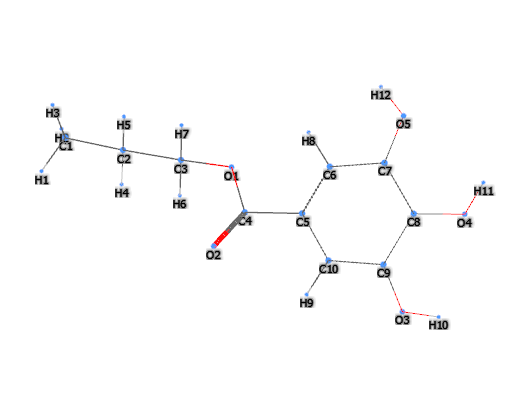| "Descrizione" by Al222 (20724 pt) | 2023-Jun-27 17:51 |
Review Consensus: 10 Rating: 10 Number of users: 1
| Evaluation | N. Experts | Evaluation | N. Experts |
|---|---|---|---|
| 1 | 6 | ||
| 2 | 7 | ||
| 3 | 8 | ||
| 4 | 9 | ||
| 5 | 10 |
Propyl gallate is a chemical compound, propyl ester of gallic acid.
The name defines the structure of the molecule:
- Propyl refers to the propyl group with the chemical formula CH3CH2CH2-.
- Gallate refers to the salt or ester of gallic acid, a type of phenolic acid, a class of antioxidant compounds known for their potential health benefits.
The synthesis process takes place in several stages and involves gallic acid and propanol:
- Preparation. Gallic acid can be obtained from various vegetable sources, such as gall nuts produced by gall wasps. Propanol is commercially available.
- Esterification reaction. Gallic acid reacts with propanol in the presence of an acid catalyst, such as sulfuric acid (H2SO4). The reaction can be represented as follows:
C7H6O5 (Gallic acid) + CH3CH2CH2CH2OH (propanol) -> C10H12O5 (propyl gallate) + H2O (water)
- Water removal. The above reaction is an equilibrium reaction, which means that it can proceed in both directions back and forth, but to bring the reaction to completion and that is to maximize the production of propyl gallate, the water produced in the reaction is often removed. This can be achieved through various methods, such as the use of a Dean-Stark apparatus or by carrying out the reaction under reduced pressure.
- Purification. The raw product of propyl gallate may contain unreacted gallic acid and propanol, as well as the acid catalyst. Therefore, it is typically purified to remove these impurities through various methods, such as distillation or extraction.
- Characterization. The final stage of the synthesis process is the characterization of the product to confirm its identity and purity. This can be done through various methods, such as infrared spectroscopy (IR), nuclear magnetic resonance spectroscopy (NMR), and mass spectrometry (MS).
In its pure form, propyl gallate is a white or slightly yellowish or brown crystalline powder.

What it is used for and where
Food
It is one of the synthetic phenolic antioxidants (SPAs) that are added to fats and fried foods as food additives to minimize oxidative rancidity of oils and fats.
Labeled with the number E310 in the list of food additives as an antioxidant
Regarding its safety, studies are conflicting.
- This study investigated the effects of mitogen-activated protein kinase (MAPK; INIbitors mek, JNK, and p38) on PG-treated calu-6 and A549 lung cancer cells in relation to cell death as well as reactive oxygen species (ROS) and glutathione levels. Propyl gallate has an anti-growth effect in lung cancer cells (1).
- In this other study, researchers aimed to develop liposomes encapsulated in n-propyl gallate through a novel direct pour method using the quality-by-design approach. A hydrogen-peroxide scavenging assay showed improved stability of liposomes containing n-propyl gallate. It can be concluded that the optimization of n-propyl gallate encapsulated liposomes coated with hyaluronic acid has great potential to target several brain diseases (2).
- Following a request from the European Commission, the Panel on Additives and Products or Substances used in Animal Feed (FEEDAP) was asked to deliver a scientific opinion on the safety and efficacy of propyl gallate as feed additive for all animal species. Propyl gallate is neither genotoxic nor carcinogenic. Propyl gallate a is safe for veal calves, cattle for fattening, dairy cows, sheep, goats, sows, horses and salmonids at the proposed maximum use level of 40 mg/kg and for ornamental fish at the proposed maximum use level of 100 mg/kg. The following concentrations (mg/kg complete feed) are considered safe for the other target species: 15 for chickens for fattening; 20 for turkeys for fattening, laying hens and rabbits; 27 for piglets and pigs for fattening and 71 for dogs. The Panel cannot conclude on a safe level for cats. The exposure of the consumer to propyl gallate and its metabolites cannot be estimated owing to the absence of reliable data on residues of propyl gallate and its metabolites in edible tissues and products. Therefore, the FEEDAP Panel is not in the position to conclude on the safety for the consumer of propyl gallate, when used as a feed additive for all food-producing animal species. Propyl gallate is irritant to skin and eyes and a dermal sensitiser. Exposure via inhalation is possible and it is considered a hazard. The use of the additive in animal nutrition does not pose a risk for the environment. The FEEDAP Panel concludes that propyl gallate has the potential to act as an antioxidant in feedingstuffs. The Panel did not see a reason for the use of propyl gallate as an antioxidant in water for drinking (3).
- Recently, there has been renewed interest in propyl gallate, a preservative in foods and fuels. This compound, which exhibits antimicrobial activity, has been found to be toxicologically safe after nearly 30 years of evaluation. Propyl gallate is an effective antioxidant-based hepatoprotectant, both in vitro and in vivo (4).
- Propyl Gallate is the n-propyl ester of gallic acid (3,4,5-trihydroxybenzoic acid). It is soluble in ethanol, ethyl ether, oil, lard, and aqueous solutions of polyethylene glycol (PEG) ethers of cetyl alcohol, but only slightly soluble in water. Propyl Gallate currently is used as an antioxidant in a reported 167 cosmetic products at maximum concentrations of 0.1%. Propyl Gallate is a generally recognized as safe (GRAS) antioxidant to protect fats, oils, and fat-containing food from rancidity that results from the formation of peroxides. Data on dermal absorption are not available, but Propyl Gallate is absorbed when ingested, then methylated, conjugated, and excreted in the urine. The biological activity of Propyl Gallate is consistent with its free-radical scavenging ability, with effects that include antimicrobial activity, enzyme inhibition, inhibition of biosynthetic processes, inhibition of the formation of nitrosamines, anesthesia, inhibition of neuromuscular response to chemicals, ionizing/ultraviolet (UV) radiation protection, chemoprotection, antimutagenesis, anticarcinogenesis and antitumorigenesis, antiteratogenesis, and anticariogenesis. Animal toxicity studies indicate that Propyl Gallate was slightly toxic when ingested, but no systemic effects were noted with dermal application. Propyl Gallate is a strong sensitizer when tested intradermally, less sensitizing when tested topically, and nonsensitizing topically at 0.1% in one study. In a second study, Propyl Gallate (15 mg dissolved in 8 ml vehicle) was sensitizing to guinea pigs. Acute eye irritation tests conducted on nine cosmetic formulations, each containing less than 1% Propyl Gallate, were negative. A phototoxicity study conducted on a cosmetic formulation containing 0.003% Propyl Gallate determined that the product was not phototoxic to guinea pigs. In one study, female rats fed 0.5 g Propyl Gallate had substantially increased fetal resorption rates when compared to controls, but in four other studies, Propyl Gallate at doses up to 2.04 g/kg was nonteratogenic in rats, rabbits, mice, and hamsters. In clinical cumulative irritancy tests, Propyl Gallate was nonirritating at concentrations up to 10%. Patch tests at concentrations less than 1% yielded positive elicitation responses. Repeat-insult patch tests using cosmetic formulations with 0.003% Propyl Gallate produced no irritation or sensitization. Propyl Gallate at a concentration of 10% in alcohol was nonphototoxic in 25 subjects. Cosmetic formulations, each containing 0.003% Propyl Gallate, produced no signs of photosensitization or phototoxicity in a total of 371 subjects. Although Propyl Gallate is not a skin irritant in clinical tests, the available data demonstrate that it is a skin sensitizer and that it may be a sensitizer at lower concentrations than originally thought, i.e., at concentrations less than 1%. In actual practice, cosmetic formulations contain Propyl Gallate at concentrations up to 0.1% and usage has increased over the past 20 years. In spite of the increased exposure associated with increased use, it is the clinical experience of the Panel that the use of Propyl Gallate in cosmetics has not resulted in sensitization reactions. Therefore, the Panel believes that a concentration limitation of 0.1% in cosmetics is necessary (given the evidence of sensitization at concentrations less than 1%) and sufficient (given that current products are not producing adverse reactions) (5).
Cosmetics
Antioxidant agent. Ingredient that counteracts oxidative stress and prevents cell damage. Free radicals, pathological inflammatory processes, reactive nitrogen species and reactive oxygen species are responsible for the ageing process and many diseases caused by oxidation.
Perfuming. Unlike fragrance, which can also contain slightly less pleasant or characteristic odours, the term perfume indicates only very pleasant fragrances.
Pharmaceuticals
Antimicrobial
The most relevant studies on this ingredient have been selected with a summary of their contents:
 |  |
- Molecular Formula: C10H12O5
- Molecular Weight: 212.20 g/mol
- CAS: 121-79-9
- UNII 8D4SNN7V92
- EC Number: 204-498-2
- DSSTox Substance ID: DTXSID5021201
- MDL number MFCD00002196
- PubChem Substance ID 24898394
- Beilstein/REAXYS Number: 1877976
- eCl@ss: 39024506
- NACRES: NA.77
- FEMA No. 2947
- NSC 2626
Synonims:
- Gallate, Propyl
- Propyl 3,4,5-trihydroxybenzoate
- Gallic acid, propyl ester
- n-Propyl ester of 3,4,5-trihydroxybenzoic acid
- 3,4,5-Trihydroxybenzoic acid n-propyl ester
References___________________________________________________________________
(1) Park WH. Enhanced cell death effects of MAP kinase inhibitors in propyl gallate-treated lung cancer cells are related to increased ROS levels and GSH depletion. Toxicol In Vitro. 2021 Aug;74:105176. doi: 10.1016/j.tiv.2021.105176.
(2) Sabir F, Katona G, Pallagi E, Dobó DG, Akel H, Berkesi D, Kónya Z, Csóka I. Quality-by-Design-Based Development of n-Propyl-Gallate-Loaded Hyaluronic-Acid-Coated Liposomes for Intranasal Administration. Molecules. 2021 Mar 6;26(5):1429. doi: 10.3390/molecules26051429.
(3) EFSA Panel on Additives and Products or Substances used in Animal Feed (FEEDAP), Bampidis V, Azimonti G, de Lourdes Bastos M, Christensen H, Dusemund B, Kos Durjava M, Kouba M, López-Alonso M, López Puente S, Marcon F, Mayo B, Pechová A, Petkova M, Ramos F, Sanz Y, Villa RE, Woutersen R, Aquilina G, Bories G, Gropp J, Nebbia C, Innocenti ML. Safety and efficacy of propyl gallate for all animal species. EFSA J. 2020 Apr 30;18(4):e06069. doi: 10.2903/j.efsa.2020.6069.
(4) Wu TW, Fung KP, Zeng LH, Wu J, Nakamura H. Propyl gallate as a hepatoprotector in vitro and in vivo. Biochem Pharmacol. 1994 Jul 19;48(2):419-22. doi: 10.1016/0006-2952(94)90115-5.
(5) Final report on the amended safety assessment of Propyl Gallate. Int J Toxicol. 2007;26 Suppl 3:89-118. doi: 10.1080/10915810701663176.
| Evaluate |

